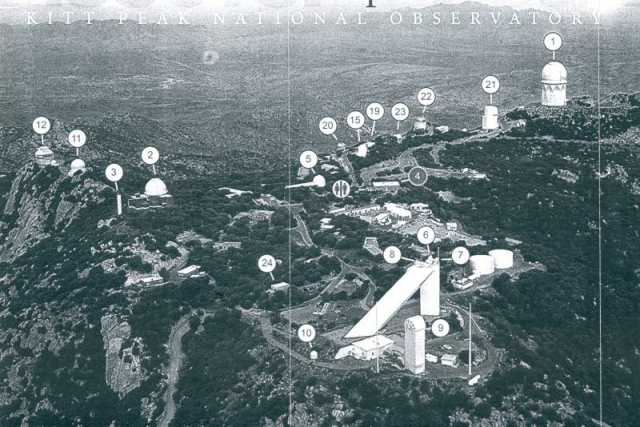
While on business in Tucson, Arizona, our eldest son, David, visited the US National Observatory at Kitt Peak, about 89km from Tucson. With 22 optical and 2 radio telescopes it is no doubt the world's largest astronomical observatory. Situated at an altitude of 2190m, above the Sonoran Desert, it was selected in 1958 after a three-year survey of more than 150 sites.
It is used by about a dozen different institutions.
Kitt Peak National Observatory:

1. 4m Mayall getting the mirror up the narrow
winding road up the side of the mountain was apparently a pretty hairy .job.
The yoke weighs 250 tons!
2. 2,1m
3. 0,9 m Coude Feed
4. 0,4m (Visitor Centre) visitors may join the Nightly Observing
Program but need to book a month ahead.
Western Kentucky University Observatory
5. 1,3m
National Solar Observatory
6. 2m McMath-Pierce (main heliostat)
7. 0,9m McMath-Pierce (E. aux., heliostat)
8. 0,9m McMath-Pierce (W. aux. heliostat)
9. 0,7m Solar Vacuum Telescope
10. 0,1m Razdow
Wisconsin, Indiana, Yale, NOAO Observatory
11. 0,9m
12. 3,5m
National Radio Astronomy Observatory
14. 25m VLBA (Very Long Baseline Array)
(not visible)
Case Western Reserve University Observatory
15. 0,6 Burrell Schmidt
Edgar O Smith Observatory
16. 1,2 Calypso
Michigan, Dartmouth, MIT Observatory
17. 1.3m McGraw Hill
18. 2,4m Hiltner
MIT/NASA Observatory
19. 0,18 ETC/RMT (Explosive Transient Camera/Rapidly Moving Telescope). For tracking UFOs?
Southeastern Association for Research in Astronomy
20. 0,9m
Steward Observatory (University of Arizona)
13. 12m
21. 2,3m Bok Reflector.
For keeping an eye on the Boks?
22. 0,9m Spacewatch
23. 1,8m Spacewatch
Wisconsin Hydrogen-Alpha Mapping
24. 0,6m
Not visible: Nos: 13, 14, 16, 17, 18
Kitt Peak National Observatory also operates the 6m Wipple Te1escope in the Tucson area.
Considering this and other US installations, some also with very Large telescopes, plus the Hubble and a couple of other space instruments, the amount or observational and research work going on around the world must be truly astronomica1!
Richard Overy